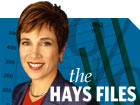
NEW YORK (CNN/Money) - So what if the U.S. economy posted a respectable 3.1 percent growth rate in the third quarter? Who cares if the Chicago purchasing managers presented a pretty dismal view of the Midwest manufacturing scene?
When all is said and done, it's the labor market that probably holds the key to the Federal Reserve's decision on interest rates next week -- and that means Friday's employment report may be the tiebreaker for Alan Greenspan and his merry band of policy-makers.
The government reported Thursday that new claims for unemployment benefits jumped by 16,000 up to 410,000 in the October 26 week. The four-week moving average fell to 402,000 -- a level high enough, economists say, to suggest the labor market isn't getting stronger, and low enough to suggest it isn't getting much worse.
As for the October employment report, payrolls is the number to watch -- that's the net number of new jobs created, or lost. In September the economy lost 43,000 jobs. The consensus forecast for October payrolls is flat to up a few thousand workers.
Bob Ried and Rudy Thunberg, longtime Fed watchers and well-known money market economists, are looking for a big 75,000 drop in October payrolls. They predict that manufacturing jobs will plummet by 60,000.
A survey out Friday from the National Association for Business Economics suggested that the labor market is not picking up much yet. The poll was taken in mid-October to reflect third quarter results.
"This quarter's survey indicates firms, while reporting stronger rising demand than last quarter, have become even more cautious about hiring and capital spending. Profit margins fell, as prices weakened slightly but cost pressures did not," said Tim O'Neill, NABE President and Chief Economist, BMO Financial Group.
"The NABE panelists' forecasts have become more pessimistic about the outlook, although they do continue to expect around a 2-3 percent growth rate for the second half of 2002. This pessimism, coupled with continued expectations of productivity gains, helps explain the weaker hiring and spending plans."
All of this explains why the pendulum suddenly has swung back toward the majority on Wall Street expecting the Fed to cut interest rates on Nov. 6. In addition, there's been a big drop in September durable goods orders (a leading indicator for manufacturing), and plunging consumer confidence. These are volatile reports, and economic optimists say they will bounce back soon.
That's why the Fed is expected to base next week's decision on rates in large part on Friday's jobs report. Remember, it's one of the four leading indicators of recession-recovery and the one economists seem to emphasize the most.
The jobless rate is expected to jump back up to 5.8 percent from 5.6 percent in September, but that might not freak out the Fed because their own forecast looks for rising unemployment.
The payrolls number is key: another negative number probably WOULD freak out the Fed, but even a modest increase could fan the fuel of economic hopes among the members of the Federal Open Market Committee and might convince the majority to hold the line on rates.
So all bets are off until Friday morning, but once the numbers are out, it's off to the races again.
Kathleen Hays co-anchors Money & Markets, airing Monday to Friday on CNNfn, and appears throughout the day reporting on the economy and how it affects financial markets. As part of CNN's Business News team, she is also a regular contributor to Lou Dobbs Moneyline.

|

